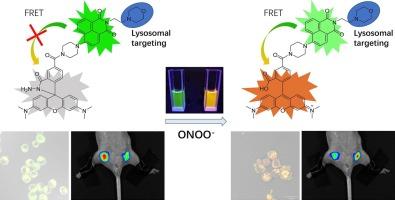一种用于体内和体外比例成像的溶酶体靶向荧光探针
IF 4.6
2区 化学
Q1 SPECTROSCOPY
Spectrochimica Acta Part A: Molecular and Biomolecular Spectroscopy
Pub Date : 2025-10-05
DOI:10.1016/j.saa.2025.127012
引用次数: 0
摘要
过氧亚硝酸盐(ONOO -)失调与各种炎症疾病的发病机制密切相关,因此准确实时监测特定亚细胞区室中的ONOO -水平对于阐明其分子机制和实现疾病早期诊断至关重要。在此,我们报道了一种基于Förster共振能量转移(FRET)的新型溶酶体靶向比例荧光探针Ro-Np,用于特异性ONOO -检测。该探针采用5-羧基四甲基罗丹明(Ro)和萘酰亚胺(Np)作为荧光团,整合吡咯烷基用于精确靶向溶酶体,并利用苯基肼部分作为ONOO−响应位点。生化评价表明,Ro-Np具有快速ONOO -检测(10分钟内)、高灵敏度(检测限为80 nM)、对其他活性物质和生物干扰的选择性好、抗干扰能力强等特点。高浓度的生物硫醇(谷胱甘肽(GSH)、半胱氨酸(Cys)、同型半胱氨酸(Hcy))存在时,会部分降低荧光强度,但不会破坏其核心比例特征。细胞共定位实验证实了其特异的溶酶体靶向性,Pearson相关系数高达0.85。重要的是,Ro-Np成功地检测了BV-2小胶质细胞中内源性ONOO−(由脂多糖(LPS)/干扰素-γ (IFN-γ)/ phorpol -12-肉肉碱-13-乙酸酯(PMA)诱导)和外源性ONOO−(由3-morpholino- sydnon亚胺(sin1)诱导),在二甲胺四环素清除ONOO−后,荧光发生可逆变化。此外,该探针在活体小鼠模型中显示出可靠的成像性能,在ONOO−处理的组织中观察到明显的绿色到红色荧光位移。此外,在脂多糖(LPS)诱导的神经炎症小鼠模型中,双光子成像显示脑组织中ONOO -水平增强,证明了探针在深部组织中ONOO -的高信噪比和高分辨率可视化能力。这些发现验证了Ro-Np作为生物系统中溶酶体靶向ONOO -检测的一种有前途的化学工具,具有研究溶酶体相关ONOO -功能和支持炎症性疾病研究的潜力。©2025 Elsevier Ltd.版权所有。本文章由计算机程序翻译,如有差异,请以英文原文为准。

A lysosome-targeted fluorescent probe for ratiometric imaging of in vitro and in vivo
Peroxynitrite (ONOO−) dysregulation is closely linked to the pathogenesis of various inflammatory diseases, making accurate real-time monitoring of ONOO− levels in specific subcellular compartments critical for elucidating its molecular mechanisms and enabling early disease diagnosis. Herein, we report Ro-Np, a novel lysosome-targeted ratiometric fluorescent probe based on Förster Resonance Energy Transfer (FRET) for specific ONOO− detection. This probe employs 5-carboxytetramethylrhodamine (Ro) and naphthalimide (Np) as fluorophores, integrates a pyrrolidine group for precise lysosome targeting, and utilizes a phenylhydrazine moiety as the ONOO−-responsive site. Biochemical evaluations demonstrate that Ro-Np exhibits rapid ONOO− detection (within 10 min), high sensitivity (limit of detection = 80 nM), excellent selectivity against other reactive species and biological interferents, and strong anti-interference capability. In the presence of high concentrations of biological thiols (Glutathione (GSH), Cysteine (Cys), Homocysteine (Hcy)), which partially reduce fluorescence intensity but do not disrupt its core ratiometric feature. Cellular colocalization experiments confirm its specific lysosome-targeting property with a high Pearson's correlation coefficient of 0.85. Importantly, Ro-Np successfully detects both endogenous ONOO− (induced by Lipopolysaccharide (LPS)/Interferon-γ (IFN-γ)/Phorbol-12-myristate-13-acetate (PMA)) and exogenous ONOO− (induced by 3-morpholino-sydnonimine (SIN-1)) in BV-2 microglial cells, with reversible fluorescence changes upon ONOO− scavenging by minocycline. Furthermore, the probe shows reliable imaging performance in live mouse models, where distinct green-to-red fluorescence shifts are observed in ONOO−-treated tissues. Additionally, two-photon imaging in a lipopolysaccharide (LPS)-induced neuroinflammatory mouse model revealed enhanced ONOO− levels in brain tissues, demonstrating the probe's capability for high signal-to-noise and high-resolution visualization of ONOO− in deep tissues. These findings validate Ro-Np as a promising chemical tool for lysosome-targeted ONOO− detection in biological systems, with potential for investigating lysosome-related ONOO− functions and supporting inflammatory disease research.
© 2025 Elsevier Ltd. All rights reserved.
求助全文
通过发布文献求助,成功后即可免费获取论文全文。
去求助
来源期刊
CiteScore
8.40
自引率
11.40%
发文量
1364
审稿时长
40 days
期刊介绍:
Spectrochimica Acta, Part A: Molecular and Biomolecular Spectroscopy (SAA) is an interdisciplinary journal which spans from basic to applied aspects of optical spectroscopy in chemistry, medicine, biology, and materials science.
The journal publishes original scientific papers that feature high-quality spectroscopic data and analysis. From the broad range of optical spectroscopies, the emphasis is on electronic, vibrational or rotational spectra of molecules, rather than on spectroscopy based on magnetic moments.
Criteria for publication in SAA are novelty, uniqueness, and outstanding quality. Routine applications of spectroscopic techniques and computational methods are not appropriate.
Topics of particular interest of Spectrochimica Acta Part A include, but are not limited to:
Spectroscopy and dynamics of bioanalytical, biomedical, environmental, and atmospheric sciences,
Novel experimental techniques or instrumentation for molecular spectroscopy,
Novel theoretical and computational methods,
Novel applications in photochemistry and photobiology,
Novel interpretational approaches as well as advances in data analysis based on electronic or vibrational spectroscopy.

 求助内容:
求助内容: 应助结果提醒方式:
应助结果提醒方式:


